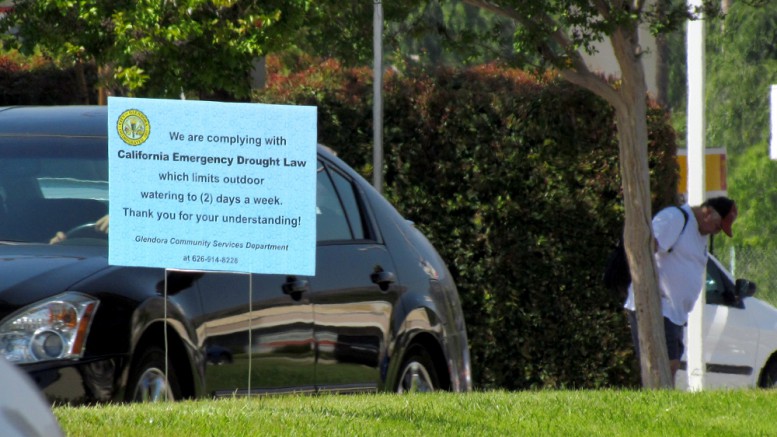Tonight, city leaders will discuss their plan of attack in dealing with Governor Jerry Brown’s Executive Order to dramatically reduce water consumption amid a worsening statewide drought.
City leaders are working through the League of California Cities to express their concerns with the State Water Board’s methodology in determining an agency’s reduction rate and plan to push Gov. Brown and the legislature to reexamine overall water use statewide.
Also being drafted is an updated comprehensive plan for compliance, which would require the city to allocate “significant” funds and shift priorities towards meeting conservation goals.
The Governor’s Executive Order, delivered April 1, includes the adoption of rate structures, surcharges, fees, penalties and possibly other methods to encourage water reductions. The Executive Order would also overhaul the Model Water Efficient Landscape Ordinance, which provides guidelines regarding new development or projects over 5,000 square feet. How much more strict this ordinance will be has yet to be seen, City Staff said.
California is in year four of an intense drought, with as much as 44 percent of the state experiencing an “exceptional drought.” As of April 8, Statewide snowpack levels, one of the chief sources of water in California, is just 8 percent of the average, according to the Energy Information Administration.
Executive Order B-29-15 requires the state’s 411 water agencies to enact conservation measures that would achieve a 25 percent reduction in water consumption across California.
The State Water Board released a draft of proposed regulations to meet Brown’s Executive Order.
Two methods would gauge compliance with the Executive Order: the 25 percent reduction compared to 2013 water usage statewide and a reduction in the residential gallons per capita per day consumption (R-GPCD).
The state is using R-GPCD data from Sept. of 2014 to determine each water agency’s reduction rate. Glendora’s R-GPCD was 228.9 last year, necessitating a 35 percent reduction between now and February of 2016 under the proposed plan.
City water officials take issue with the use of R-GPCD, stating it is an “extremely subjective” measurement and fails to consider key variances between communities.
“It’s an inaccurate tool to measure conservation. It’s not reflective of what’s happening across a suburban area. It shouldn’t just be focused on residential. Water companies should be allowed to reduce overall consumption. A water supplier is going to know their customer base better than the state,” said City Manager Chris Jeffers.
Jeffers said the city also believes that focusing on R-GPCD undermines the historical water reductions that Glendora has undertaken. When using three-year annual average numbers, Glendora reduced its water consumption by nearly 52 million gallons from 2008 to 2013.
Since enacting Stage I conservation measures in 2009, Glendora has reduced usage by just over 12 percent. The city has also increased the number of customers participating in the rebate program and the number of water efficient devices installed.
In a previous interview, Glendora Mayor Karen Davis said the city has a head start on conservation methods for private residents, including the turf removal program and restrictions for new development.
Other conservation methods already implemented include:
Median Turf Removal
- 2012 – 17,805 square feet removed from 15 medians on Grand Avenue
- 2015 – 1,605 square feet removed from Financial Way
Facilities Turf Removal
- 2011 – 12,120 square feet removed from Art Cook Park
- 2012 – 10,900 square feet removed Willow Springs Park
- 2013 – 14,000 square feet removed from South Hills Park
- 2014 – 10,000 square feet removed from the Crowther Teen Center
- 2015 – 5,600 square feet removed from Glendora Historical Museum and Parks Nursery
Conservation Devices Installed
- 2014 – Drip system installed on 45 street medians
- 2014 – Honeywell Energy/Water Program (Weather Readers/Smart Controllers)
Additional turf removal projects are taking place at Pompei Park (70,000 square feet), Passive Park (22,000 square feet) and at the Big Tree Park expansion (3,610 square feet).
“The programs that we have already put in place have made a substantial difference, and have helped ‘prime the pump’ for further restrictions and conservation,” Davis said.
City leaders are also very interested in what the Governor’s Executive Order will mean for Glendora with Prop 218 and Prop 26.
Proposition 218, approved by voters in 1996, generally ensures that most charges and taxes on property owners must be voter approved while seeking to prevent what some have seen as an abuse in using assessments and property-related fees, according to the Legislative Analyst’s Office.
Prop 26, passed in 2010, requires a two-thirds supermajority vote in the state Legislature to pass many fees and other taxes, according to Ballotpedia.org.
City leaders also acknowledge that residents will play a pivotal role in helping Glendora comply with Gov. Brown’s Executive Order.
“Our customers are going to be key components in meeting our conservation goals. They have been extremely responsive over the last seven years and that is why we have the conservation we have to date,” City Staff said.
Glendora would need to heighten its interaction with residents, require a significant increase in an educational outreach and incentivize water customers to comply, Jeffers said.
The proposed regulations may still undergo changes before they are scheduled to be adopted May 5 or May 6, after which city leaders will unveil a comprehensive updated plan for compliance.
The status report will be discussed at the City Council meeting, scheduled for 7 p.m. in the Council Chambers, 116 E. Foothill Blvd.






